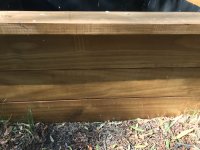Jmacpherson
Member
- Joined
- Jun 9, 2016
- Messages
- 215
Need some advice guys.
Note - no tablesaw, no thicknesser and no jointer so not an option for me otherwise I would have tried these methods before assembly and not have posted this.
Sit rep:
Purchased pressure treated pine 69x69x2m to be used in outdoor box joint planter box.
It was wet when purchased due to it being towards end of winter/spring here at the time and I left it indoors to dry.
As the wood dried some of the lumber twisted on both ends in opposite directions and warped in the process. - my fault, should have used when wet and/or changed how I stored it
I used the best pieces from the bottom up but now I've run into the worst pieces.
I worked around the issue with clamps, spreader clamps and spax screws.
I tried using my Rotex 90 on some of the twists but got nowhere fast so changed to my EH 65 planer instead to get rid of the worst of it and to sort of level the tops off for the next level.
I'm still contemplating cutting it up for firewood and starting again with different wood - been very, very close a few times but stuck at it.
On the sides of the planter (I will upload pics later) it is very uneven and will get worse as wood is added and will need to be blended in/flattened out.
I have a Rotex90 and ETS 150/5 EC but they are not going to handle this.
Rotex 150:
Is it aggressive enough for flattening uneven timber and even twister timber in a pinch?
BS 75:
Or is it better to rather throw money at something like the BS 75 since it comes with the ability to clamp it to the workbench and bring wood to the tool?
The sanding plate assists with keeping things straight, would it work on something narrower than the actual belt?
The guide attachment/stopper/fence how well does it work and would it help in my situation for the unattached pieces?
Or is it sometimes worth throwing in the towel and starting again with different wood species?
If I go with untreated dry pine, the replacement wood will cost me +/- 50% of a Rotex 150 or BS 75 but the wood will not last as long down the road.
If I go with Meranti, will cost me the same as buying a brand new Rotex/BS75. Wood is expensive here.
(And it will be the wrong colour, my wife will not be happy [embarassed])
Note - no tablesaw, no thicknesser and no jointer so not an option for me otherwise I would have tried these methods before assembly and not have posted this.
Sit rep:
Purchased pressure treated pine 69x69x2m to be used in outdoor box joint planter box.
It was wet when purchased due to it being towards end of winter/spring here at the time and I left it indoors to dry.
As the wood dried some of the lumber twisted on both ends in opposite directions and warped in the process. - my fault, should have used when wet and/or changed how I stored it
I used the best pieces from the bottom up but now I've run into the worst pieces.
I worked around the issue with clamps, spreader clamps and spax screws.
I tried using my Rotex 90 on some of the twists but got nowhere fast so changed to my EH 65 planer instead to get rid of the worst of it and to sort of level the tops off for the next level.
I'm still contemplating cutting it up for firewood and starting again with different wood - been very, very close a few times but stuck at it.
On the sides of the planter (I will upload pics later) it is very uneven and will get worse as wood is added and will need to be blended in/flattened out.
I have a Rotex90 and ETS 150/5 EC but they are not going to handle this.
Rotex 150:
Is it aggressive enough for flattening uneven timber and even twister timber in a pinch?
BS 75:
Or is it better to rather throw money at something like the BS 75 since it comes with the ability to clamp it to the workbench and bring wood to the tool?
The sanding plate assists with keeping things straight, would it work on something narrower than the actual belt?
The guide attachment/stopper/fence how well does it work and would it help in my situation for the unattached pieces?
Or is it sometimes worth throwing in the towel and starting again with different wood species?
If I go with untreated dry pine, the replacement wood will cost me +/- 50% of a Rotex 150 or BS 75 but the wood will not last as long down the road.
If I go with Meranti, will cost me the same as buying a brand new Rotex/BS75. Wood is expensive here.
(And it will be the wrong colour, my wife will not be happy [embarassed])



